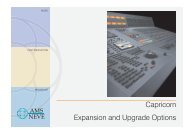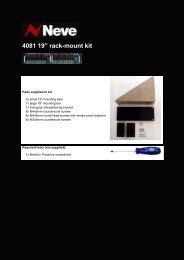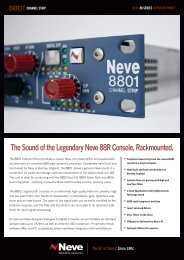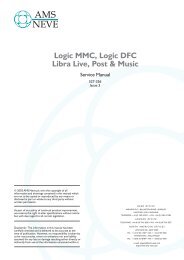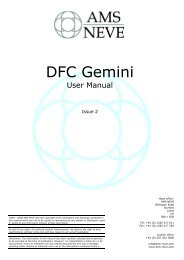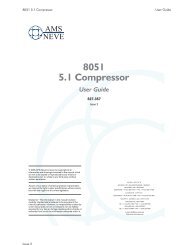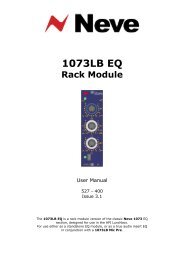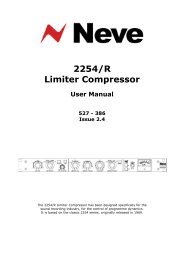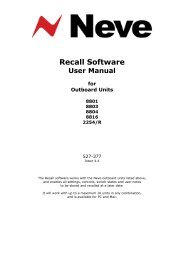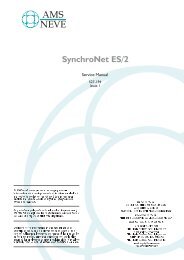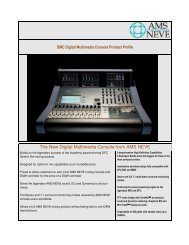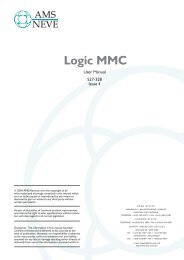User Manual - AMS Neve
User Manual - AMS Neve
User Manual - AMS Neve
Create successful ePaper yourself
Turn your PDF publications into a flip-book with our unique Google optimized e-Paper software.
SynchroNet ES/2 <strong>User</strong> Guide<br />
Getting Started<br />
Operation modes<br />
When using the editor’s transport controls, the emulator performs all of the usual machine<br />
movement commands. You should bear in mind that some audio transports cannot be ‘jogged’ in<br />
as controlled a fashion as a video machine.<br />
Performing an edit is completely transparent to the operator. The machine is cued to the Record In<br />
point minus preroll and is ‘Servoed’ into lock by the editor. As the machine is rolled through the edit<br />
points it is running locked to the selected timeline reference. If you have selected the Emulator as<br />
the record machine, then Record In and Record Out commands will be issued at the appropriate<br />
times. Subframe offsets may be entered into the ES/2 if required.<br />
Slaving to a video Machine<br />
Many video transports have the capability of performing the functions of a simple editor. A second<br />
video (or in our case the Emulator) is connected to the 9 pin remote connector on the video<br />
machine. This second machine is then controlled as the “player” by selection buttons on the master<br />
machine<br />
Record Enablement<br />
Record priming facilities are normally provided by the Editor. In other cases you can locally select<br />
record enablement on the ES/2 by using the Local Options Menu. In some cases the hardware<br />
track selection capability of the ES/2 parallel port can also be used (see Appendix C).<br />
<br />
The ES/2 will not issue Record commands if lock is not achieved.<br />
Emulator Chase Master<br />
It is possible to have a number of further ES/2s connected together on the B-bus and selected to be<br />
chase slaves. These will follow the operations of the emulating ES/2 in the same way as in a<br />
conventional chase system. The editor (or DAW controller) will not be able to access these slaving<br />
machines directly but offsets can be trimmed on the ES/2 front panels.<br />
Emulator Mixed Code<br />
In some instances you may want to run a machine which is not at the same standard as the<br />
controlling device. For example a 24fps film machine from a PAL editor. If the ES/2 is set as a<br />
timeline master referenced to crystal or an external signal then the frequency of the reference is<br />
used to define the “system” standard. The “machine” standard is determined in the usual way from<br />
ltc , tach or serial information. If these two standards are different then Mixed Code operation is<br />
invoked. Normally this happens automatically and does not require operator intervention. You can<br />
tell that this mode has been engaged by the “MIX” indication in the normal menu. The controlling<br />
device sees the ES/2 as if it were a machine of its own type. It is also possible to force the mixed<br />
code system on by the use of a machine parameter.<br />
See Mixed Code Emulation below.<br />
Issue 2 2:11




